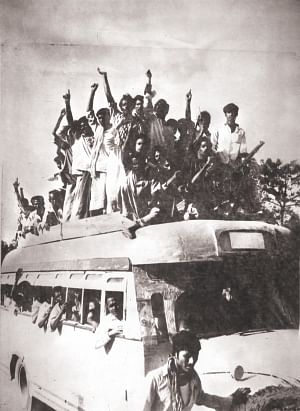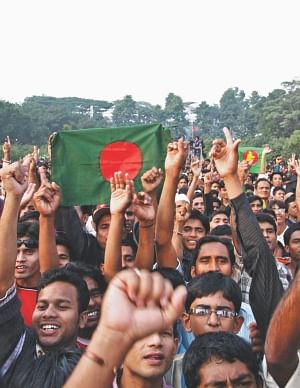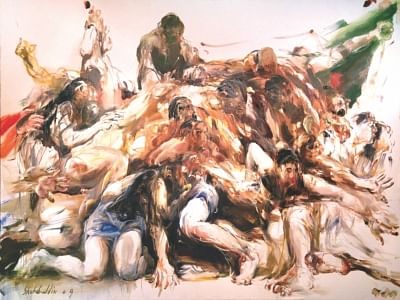| Home - Back Issues - The Team - Contact Us |
 |
| Volume 11 |Issue 49| December 14, 2012 | |
|
|
In Retrospect Those Magnificent Sixty One of the Epoch Making Seventy One Major (rtd) Syed Mizanur Rahman, psc
I was a fun loving nineteen-year-old studying medicine at the Dhaka Medical College when the Pakistan Army cracked down on innocent civilians and our Bengali soldiers serving with them on March 25, 1971. On actually witnessing the carnage on March 27 around Iqbal Hall, Jaganath Hall and the Sweepers' Colony in the Dhaka University, my twin brother and I were horror-struck. Never in our wildest dreams could we have imagined the brutality unleashed by the savages of the corrupt Pakistan army. We had seen about thirty dead bodies of mostly women and their children in the sweepers' colony. We had never seen so many dead bodies ever in our lives. My whole perception of life changed forever! Uncertainty loomed all around. I was not sure of the cushy middle class future that I had grown up dreaming. My whole world was turned upside down. We trudged back home numb and narrated what we had seen to our other siblings. They were equally horrified. We got glued to our transistor trying out BBC, ABC and VOA. In the evening we got a faint voice on the medium wave claiming independence of Bangladesh. The announcer claimed that he was Major Ziaur Rahman. We were all very excited, my twin brother and I started thinking of joining the resistance though we could not let our caring family know about this. Having failed our first attempt in April, we finally made it on May 23! Four of us (Munib, Shahriar, Didar and me) - all classmates at Faujdarhat Cadet College hired a baby taxi from in front of New Market and reached Chandina at noon. My brother and I had left a curt note on top of our favourite record player (Philips) “We are going east. Do not try to find us.” From Chandina we walked across the border amid many risks of being arrested by the cohorts of the cowardly Pakistan army. Late in the evening we landed up in a Muktibahini camp called Hatibandha. The next day we reached the now famous Motinagar camp where Sector 2 headquarters was located. We found many known faces from Dhaka at that camp. We met Capt Haider and were eagerly waiting to meet the charismatic Major Khaled Mosharraf. Our basic training started immediately and we started with real weapons that were designed to kill people. A week later the whole camp moved to Melaghar and we all walked the whole night to reach the new site, full of large trees and big rhesus monkeys. From our Melaghar camp, sixteen young men were selected to join the First Bangladesh War course. It would be in total SIXTY ONE young men finally landing up at the adhoc Officers Training Camp at Murtee - North East of Shiliguri. Our course, the First Bangladesh War Course started on 21 June 1971 with 61 Gentlemen Cadets selected from ten different sectors of Bangladesh Forces. The selection was done through interviews by a panel of officers, followed by medical tests. We were mostly students from Dhaka University, Dhaka Medical College, Engineering University, and Chittagong City College etc. Some of us were in jobs in the private sector. Because of this diverse background, our age varied from nineteen-year-olds to some nearly in their thirties! But we all had one aim in common - to get trained as officers and liberate our country from the Pakistani occupiers as soon as possible. We all gathered at Murtee from all the sectors of war, mostly travelling by train up to Chalsa and then to Murtee by Shaktiman trucks. The camp was run by ECHO sector of the Indian Army under Brigadier Joshi. It had two wings, namely Bhashani Wing to train Freedom Fighters and Mujib wing to train Officers. We were the privileged first batch of officers of Bangladesh Forces to be trained at the Mujib Wing. Murtee Camp was located in a tea garden on the bank of Murtee River. The camp was composed of tin roof huts to serve as our living accommodation. Murtee River was a fast-flowing river with crystal clear cool water where we bathed. On clear days, if we looked north from our camp, we could see the Bhutan Mountains in the distance.
The Commandant of the officers' wing was Col Das Gupta who had a number of officers under him to train us. Major Asman Singh Thapa of 5 Garewal Regt was the Wing Comd of our wing and was supported by three Squad Comds, namely Capt Sthanapati of Madras Regt, Capt Jadav of Artillery and Capt R P Singh of 2 Maratha. There were other instructors for different subjects like FE- Major Jadav of Engnrs, Capt Chandan for Tactics and others. I must add that all our instructors were highly competent trainers specialising in practical applications of the theories learnt in the class rooms. Night training was given particular emphasis. Once we returned to our barracks, each of us would have a few leeches stuck to our bodies. When we slept, we suffered from bites of the famous Murtee bed bugs! We were trained for 15 weeks intensively day and night to turn a bunch of civilians into army officers to lead Companies on battlefields. Strict discipline was maintained and we lived a very Spartan life. The training turned all 61 of us into highly motivated and well-trained officers of the Bangladesh Forces. This is possibly the only course that had all sixty one of us joining infantry units in the heat of the battlefields. We passed our course on October 9, 1971, with Nazrul Islam, the acting President of Bangladesh Government in exile reviewing the parade. Along with him was Mr. Tajuddin Ahmed, the then Prime Minister and General Osmani, Commander of Bangladesh Forces. The passing out parade was followed by a sumptuous lunch and that was our first decent meal in fifteen weeks. General Osmani advised us as Subalterns to “keep your mouth shut and keep your bowels moving” which made us laugh loudly. We received our posting orders and all 61 of us were sent to the ten sectors of Bangladesh Forces as Commissioned Officers, some with sector troops and others with the famed East Bengal Regiment, of which there were five existing and two newly raised. Only Sheikh Kamal, son of Bangabandhu was retained by General Osmani as his ADC. Murtee had made us physically fit and mentally focused to take on the new challenges head on. Our presence in mid October in all the ten sectors of operation gave a huge moral boost to the troops. It was a dream come true for the ten Sector Commanders of Bangladesh Forces as we immediately assumed the duties of Company Commanders and sub-sector Commanders on different battlefields all around Bangladesh. This meant that the Bangladesh Forces were now ready to take on the Pakistan Army in a major escalation of operational activities all across Bangladesh, with a batch of sixty newly commissioned officers. As for me, I was posted to a newly raised unit called 10 East Bengal Regiment, located at Rajnagar in the State of Tripura. Rajnagar is situated on the north western tip of the famous Belonia bulge. Also located in the same area was the famed 2nd Rajput Regiment of Indian Army, commanded by Colonel Dutt. A young handsome Lieutenant was the IO of the unit and his name was Lt V K Singh (later to be made the COAS of Indian Army).
We lost 2/Lt Aziz in Sector 2 and 2/Lt Samad in Sector 6 during the ensuing months. We also lost 2/Lt Salim in January 1972 while his unit was clearing Mirpur in Dhaka of the remnants of Pakistan army. For courageous actions in the War, nineteen of our course mates were given Gallantry awards, one Bir Uttam, two Bir Bikrams and the rest Bir Protiks. Our Course made a major impact in the outcome of the War of Liberation since we joined our units in mid October 1971. Our Country was liberated in two months with the active support of the Indian Army. It is a matter of historical truth that the First War Course had contributed immensely in the War of Liberation of Bangladesh and I can echo the words of the great Captain of War Sir Winston Churchill that “never had so few made so much difference to so many.” I along with 2/LT Didar joined 10 E Bengal Regiment at Rajnagar of Tripura district on October 13. We were both received by Major Jafar Imam and assigned as Company Commanders. The next day we visited the Forward Defence Locations manned by the troops of our two companies, along the River Muhuri on the northern edged of the famous Belonia Bulge. We could see the fortified bunkers of the Pakistan army- 25th Baluch regiment to be precise. On November 6, we started the great infiltration operation to liberate the bulge. We were ably supported by the 23rd Mountain Division of the Indian Army. The major battles were fought at Chitholia, Dhanikunda, Fulghazi and Pathan Nagar. And finally after a month on December 6, we liberated the strategic town of Feni and practically cut off the land (road and rail) link between Chittagong and Dhaka. The end game for the Pak Army had just BEGUN! The writer is a Muktijoddha and currently the President of Bangladesh War Courses Foundation. The Foundation is composed of the two officers' courses started during the War of Liberation.
Copyright
(R) thedailystar.net 2012 |


